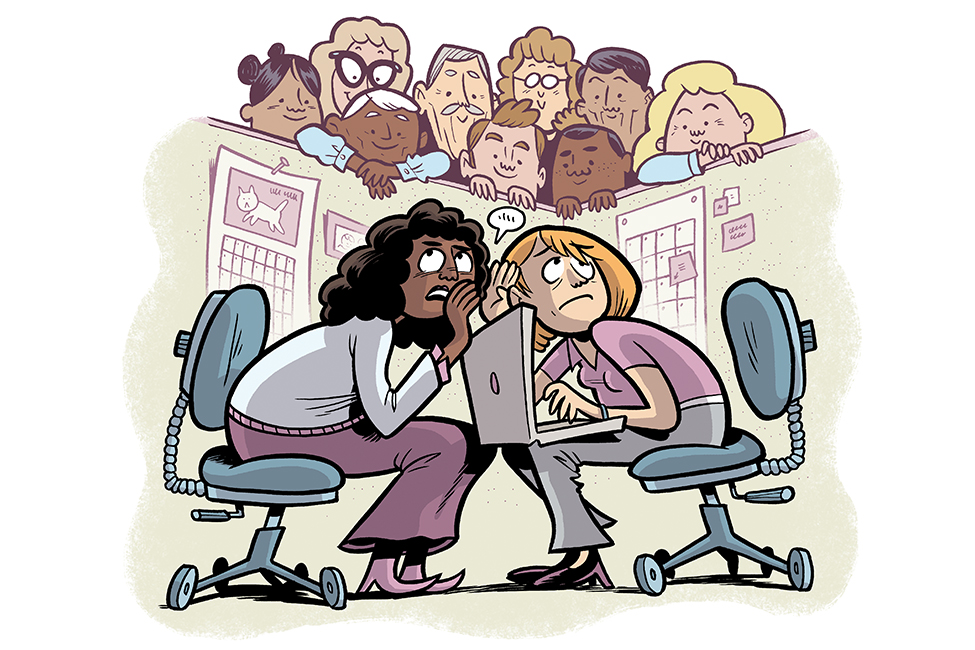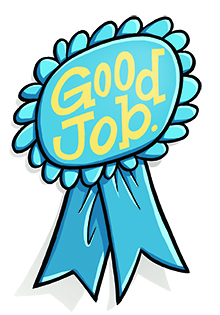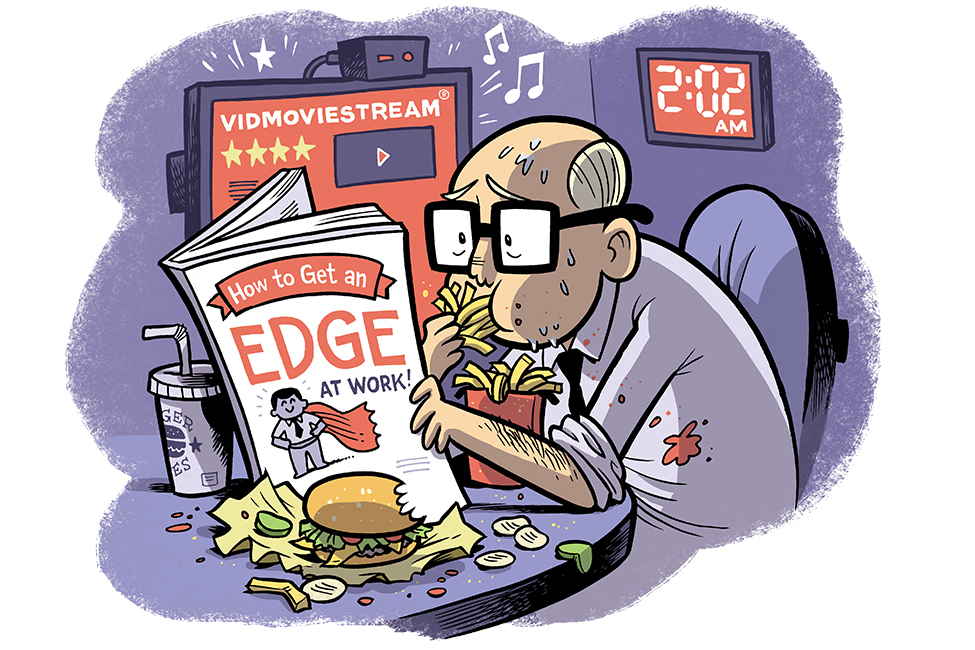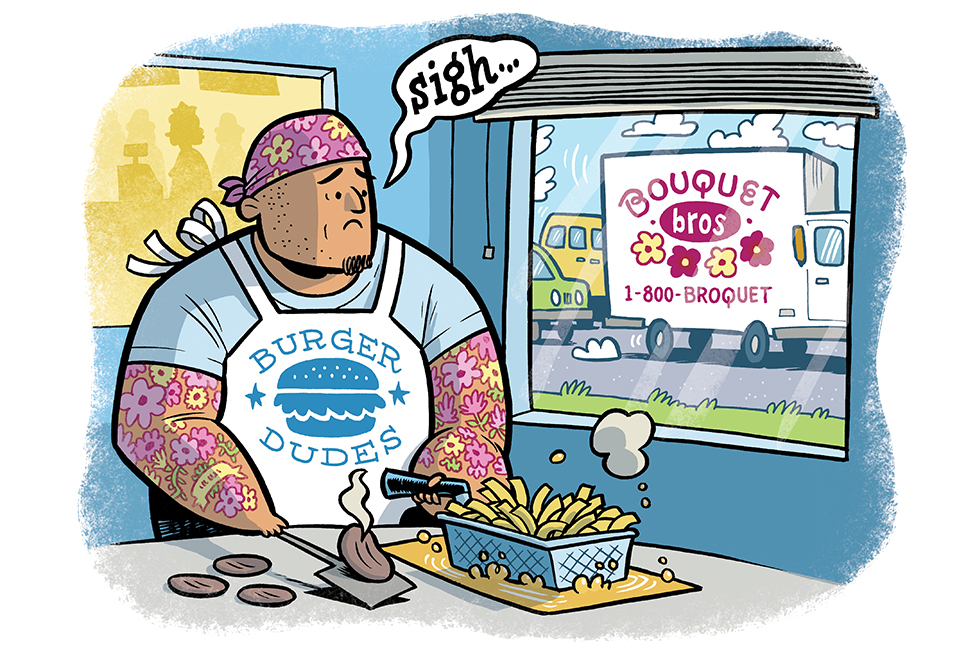When Work Doesn’t Work as Well as It Could or Should
If you’re like the majority of Americans, you’re probably not too thrilled with your 9-to-5 grind. (That may start with the fact that your 9-to-5 grind is actually closer to an 8-to-6 — or even 24/7 — grind.)
According to a 2014 survey by the nonprofit research group Conference Board, a full 52.3 percent of us are unsatisfied with our jobs.
And that dissatisfaction extends even to Grinnell alumni — smart and driven people who might otherwise seem to have every advantage in the workplace today.
So what’s going on, and how can we fix it? In this story, we talked to Grinnellians who are zeroing in on the problems of, and the solutions for, today’s working world.

Open office or closed doors?
Office design can help or hinder our work. Paula Briggs Fracasso ’89 shares ways to understand your office space’s strengths and overcome its weaknesses.
The freewheeling atmosphere of Silicon Valley startups hasn’t just led to billion-dollar behemoths like Uber and Airbnb; it’s also influenced office design from coast to coast.
These days, office designers everywhere are taking their cues from fast-growing tech companies. You’re probably familiar with the look, and you might spend your weekdays in something just like it: Such offices favor wide-open spaces over individual offices with actual doors, polished concrete over industrial-strength carpet, and incandescent bulbs over headache-inducing fluorescent lighting.
Unfortunately, the covetable look doesn’t necessarily translate to productivity or employee satisfaction, says Fracasso, an executive coach. “I’ve worked with people at Fortune 500 companies who make well over six figures a year who admit that the only place they can have private conversations is in the parking lot,” she says.
Yet buttoned-up workplaces where every office has a door, and maybe even a lock, might not be much better. After all, such layouts likely speak volumes about the office’s interest in collaboration and camaraderie.
In the end, Fracasso says, great design focuses on how people in the company actually work best — and translates that into spaces that work. In general, that means a more thoughtful mix between public and private spaces. “It never makes sense to design an office based solely on what looks cool in a magazine,” she says.
Take action: Stuck in one office-design extreme or the other? There are always workarounds. Fracasso offers two:
- For open spaces, “library rules” for the first couple hours of the day can help people stay focused on deep work.
- Remote offices can get a boost with “virtual social hours” that promote interaction even among faraway colleagues. “Office design has a huge impact on company culture,” she says. “The goal is to inject a little bit of humanity in these environments.”
When knowledge isn’t power
Our own terrible habits may be to blame for our bad attitude and poor performance at work, says Billy Strean ’86. What does it take to change them?
Speaker and performance coach Strean often works with high-level executives who are desperate to get an edge in their work — but all too often, he says, they’re looking in the wrong place. “People are willing to do so many sophisticated and expensive things to perform at a higher level, but they might not be doing the fundamental things that would help them: sleeping, eating well, drinking water, getting exercise,” he says. “They’re trying to build a house on a really shaky foundation.”
This might sound like old news. After all, most of us understand that we shouldn’t be binge-watching Orange Is the New Black until 2 a.m., and few of us feel great about the fast-food lunches we eat at our desks. Even Strean admits he’s guilty. “When I work in front of a 27-inch computer screen right before bed — I might as well be sitting in front of the sun. Should I really be surprised that I can’t go to sleep an hour later?” he jokes.
Your brain is sabotaging you: Intellectually understanding that we need more sleep and more exercise won’t make us change, and reading this article might not do much for you, either.
One thing that might make you change a habit is an emotional gut punch. “Most people don’t analyze their way to change,” says Strean, echoing the ideas of Harvard professor and consultant John Kotter, who argues that when people see something that has them feel something, then they change.
In other words, reading one more fact-packed article about the benefits of sleep won’t lead you to a good night’s sleep that will help you on the job. But seeing how much better you feel and how much more effectively you work? That might cause you to see the potency of the issue — and lead you to set aside your late-night Netflix binges for good.
Is it time to toss the organizational chart?
Strict hierarchies may be dragging all of us down, says James Jennings ’87.
As one of the world’s first management consultants in the early 20th century, Frederick Winslow Taylor offered plenty of theories about how to make workers on the factory floor more efficient. One of his biggest ideas? Divide the work up so that managers do the thinking and planning while the workers perform the tasks.
In many cases, Taylor’s principles did lead to greater productivity and — perhaps more important to company owners — bigger profits. But as more companies adopted his approaches, including many firms that didn’t focus on manufacturing, their effectiveness dwindled. Even worse, the side effects were devastating, says Jennings, founder of @1, a company that helps individuals and companies build better systems to do better work.
“People lost a sense of ownership in the work that they were doing when they were simply told what to do,” Jennings says. “The idea, in this economy, that there are a small number of people who know what the answer is and everyone else should just do what they say is obsolete.”
You’ve probably experienced a version of this in your worst jobs. You feel like you’re little more than a cog in a machine. In the end, it might not even be good for productivity, says Jennings. “The people who are assembling understand assembly better than the people who are watching it. There’s value to the experience of doing the work.” In other words, technicians in every field have plenty of insights that their managers would be wise to heed.
 So what’s the best way forward? Jennings argues that giving workers at every level more agency and discretion in their work can make a big difference not only in worker happiness but also in the progress of an organization.
So what’s the best way forward? Jennings argues that giving workers at every level more agency and discretion in their work can make a big difference not only in worker happiness but also in the progress of an organization.
Such approaches have already been proven in some organizations. Online retailer Zappos, for instance, famously tossed the word-for-word scripts that are typically used in customer service calls so that that employees could use their creativity and empathy to solve callers’ problems.
Jennings, too, saw benefits to this approach. Years ago, while working as a manager at Keurig, he called meetings with his entire team — from sales to accounts receivable to delivery — and found that some profitable but unpleasant clients were bringing everyone in the division down. “When people on the team started talking to one another, they realized that certain clients were horrible to everyone — demanding discounts from sales people and leaving customer service reps in tears,” he says.
Together, they came up with the solution to drop the most disagreeable clients, even if it meant lost revenue. “And it turned out when people didn’t dread those parts of their job, they did better,” he says. “We ended up improving customer satisfaction, employee satisfaction, and growth rate.”
The point, says Jennings, is that he wasn’t a hero. The collaboration his team did, and the authority they all had to make good decisions, drove the team to success in the way Jennings couldn’t have done on his own. “It’s important to build a culture that allows for more discretion in decision-making,” he says. “It’s time to start democratizing information and power.”
What to ask before you take that new job
The answers could determine how satisfied you’ll be in the new role.
Job interviews are a two-way street. Just as employers want to get a good sense of a candidate through good questions, candidates should be doing some tire-kicking of their own. Because companies are well-versed in putting their best foot forward as they describe the work, the perks, and the growth opportunities of a given position, candidates should be asking questions to uncover the deeper truths of an organization to see if it will truly be a good match.
Alison Hayes ’87, who has worked with James Jennings at @1 and has long been interested in what makes a company good for employees, suggests a few questions that can provide needed insight for a job candidate:
Q. How is great work recognized?
A. A Starbucks gift card or a superficial “good job” from the boss? “Ask people to describe a time they did work they were really proud of and how that was recognized,” says Hayes. “‘It meant a lot to me when my boss …’ is a good sign.”
Q. What does feedback look like?
A. It should go beyond annual reviews. “You don’t want someone who tells you once every 12 months if you get a thumbs up or thumbs down,” she says. “You want to know if you’re on the right track so you can proceed confidently or adjust in the moment — not six months after the fact.”
Q. How much time do employees spend using their best skills?
A. Anyone who says 100 percent is lying — even the best jobs have crummy parts — but the ratio should be something you’re comfortable with. “If people say 80 percent of their work is administrative and they spend just 20 percent doing the work they’re excited about, that’s a red flag,” she says.
Q. Can employees safely challenge themselves?
A. You’ll want to be confident not only that you’ll have a chance to take on projects that stretch your skills, but also that your boss and company will have your back even if your best efforts fail. “You want to know that if you push yourself hard and take risks, you won’t be cut loose if you occasionally fall down,” she says.
Why the “just a job” mindset can be devastating
Indifference about your work is likely to have consequences that spill into your off-hours.
Plenty of people are working for the weekend. Clocking in and clocking out is just a way to pay the bills, not part of a larger sense of identity.
But could that “just a job” mentality have troubling consequences? Jim Asplund ’88, chief scientist of strengths development for Gallup, says that research done by his firm suggests that a job we don’t love could have a powerful effect on our stress levels and overall happiness. Here’s how:
Twenty-one percent of all Americans say they use their strengths to do what they do best for fewer than three hours per day. They are far more likely than those who use their strengths four or more hours per day to report that they are experiencing worry, stress, anger, sadness, and pain.
Asplund says, “We thrive when we’re doing things we’re inclined to do anyway. Even if we know we can do things that come a little less naturally to us, [this work is] less likely to energize us and allow us to do the kind of work that makes it feel like time is passing quickly.”
The more hours per day that adults believe they use their strengths, the more likely they are to report having ample energy, feeling well-rested, being happy, smiling or laughing a lot, learning something interesting, and being treated with respect.
“Not only are you more productive when you’re working in your areas of strength,” Asplund says, “you’re happier, too.”
Make your current job your dream job
We may all fantasize about a dream job where we know we’d flourish, but the reality is that many of us are tied to the one we’ve got. Maybe we’ve got loans to pay off or nearby family who’d be devastated if we left. Maybe the job we’ve got is actually pretty good, once we consider the alternatives.
Even if you’re not planning to jump ship to a new job, there are steps you can take today to feel happier and more purposeful in your work, says Mark Henry ’05, global talent development manager for Aon Corp. “Employees should be able to find new challenges and experiences at work that make them feel fulfilled,” he says, “especially Grinnellians, who are curious about the world and like to think a little bit bigger about things.”
1. Start with a positive attitude.
Incompetent bosses and lazy co-workers are infuriating, but griping about every last detail of your day-to-day tasks won’t endear you to the people who can help you most. “You can’t let your inner kindergartner come out,” says Henry.
2. Find ways to eliminate the tasks that bog you down.
Start with an accounting of your daily activities, tiny details included. If there are projects that you find particularly draining, think creatively about how you might get them off your plate. “You might find that there are ways to streamline certain processes, hand them off to people who like them or are more equipped to deal with them, or remove processes altogether,” says Henry. With the right positioning, you can show how replacing the tasks you loathe with ones you love will lead you to do better, more high-value work that will benefit your organization.
3. Dig deep on your interests.
There are an almost infinite number of self-assessments that you can take, but you can start simply by paying attention: When do you find yourself so engaged that you lose track of time? If you feel those moments don’t exist for you in your current job, a co-worker or friend can help. “Ask people around you when they have observed you at your best, or when they see you truly light up,” says Henry. “They can often see things about you that you can’t see yourself.”
4. Connect your interests to the company’s or boss’s goals.
Does your list of strengths connect up with some larger company objective? Can you make the case that the things you want to pursue in greater depth will lead to higher profits, improved product quality, or faster response times? Such results will likely be music to your boss’s ears. “Move away from simply saying ‘I want this, I want that,’” says Henry. “Figure out a way to make your passion something that your company can’t afford to be without.”
5. Find your own vision.
On a day-to-day level, it can feel like all you’re doing is sending out emails or creating PowerPoint slides, but if you can connect the daily work to something larger — whether it’s the mission of the organization or just making the lives of co-workers a little bit easier — it can lead to a sense of purpose. Just as a bricklayer who sees her work as building cathedrals instead of stacking bricks is more likely to be satisfied, finding your own purpose is likely to lead to greater work happiness. “Find your cathedral,” says Henry.



